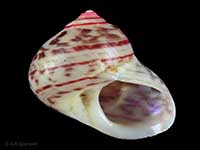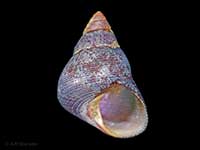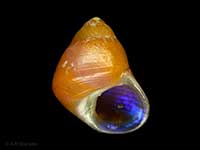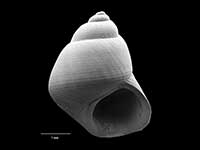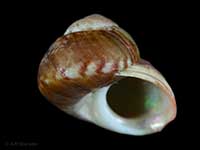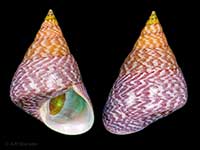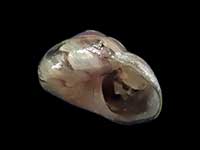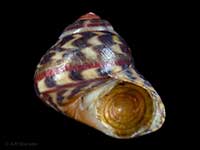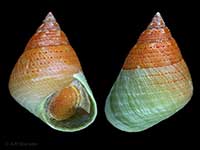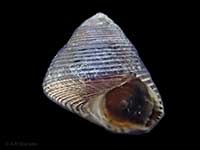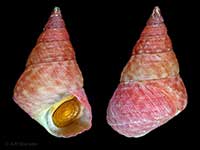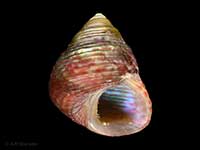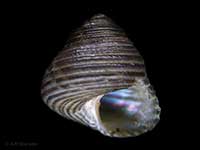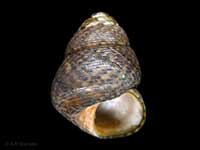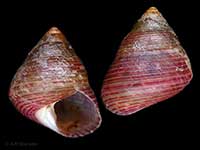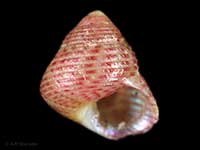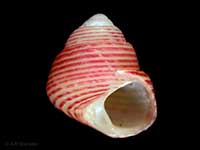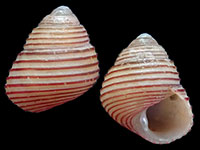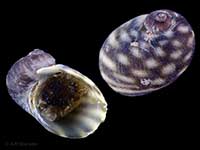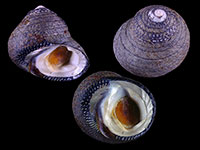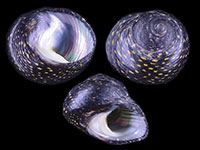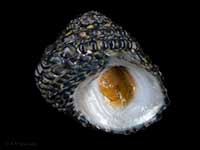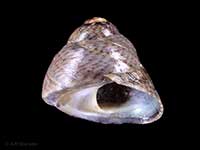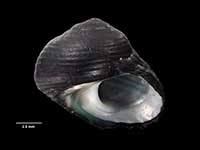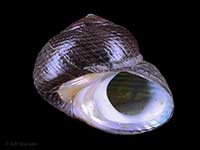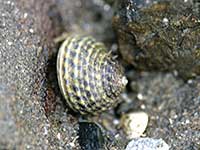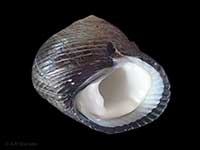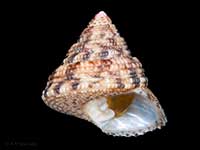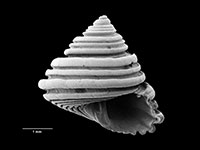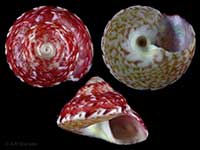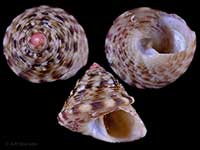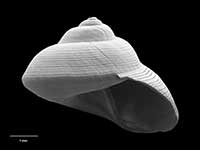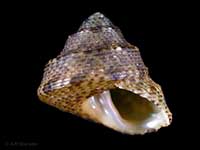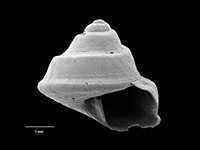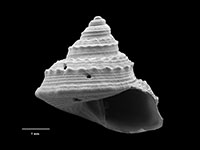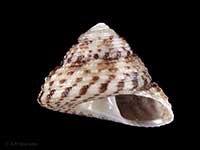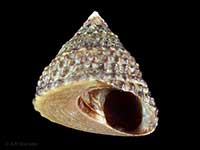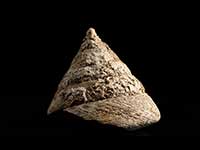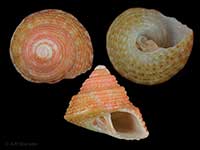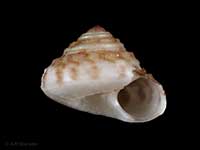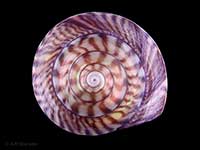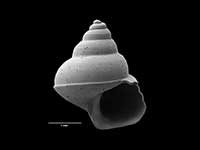Mollusca (Phylum) > Gastropoda (Class) > Vetigastropoda (Subclass) > Trochida (Order) > Trochoidea (Superfamily) > Trochidae (Family)
 Filter region:
Filter region: 
(greyed out images not recorded from filtered region)
 Click here to filter list on Geographical Range
Click here to filter list on Geographical RangeFamily: Trochidae
- Cantharidus antipodum (Hombron & Jacquinot, 1854)
Width 12mm, Height 10mm
Marine, Native - Endemic
South Island, Otago to Stewart Island, Snares, Campbell, Auckland and Antipodes Islands. Under kelp holdfasts - Cantharidus capillaceus (Philippi, 1848)
Height 28mm, Width 20mm
Marine
Auckland, Campbell and Antipodes Islands - Cantharidus dilatatus (G.B. Sowerby II, 1870)
Height 9mm, Width 8mm
Marine, Native - Endemic
North, South, Stewart and Chatham Islands. On kelp at low tide to about 5 metres - Cantharidus festivus (B.A. Marshall, 1998)
Height 6.2mm
Marine, Native - Endemic
Off Three Kings Islands and off Cape Reinga, Far North, 13-88 metres - Cantharidus fulminatus (Hutton, 1873)
Width 8mm, Height 8mm
Marine, Native - Endemic
Chatham Islands, intertidal to shallow water - Cantharidus opalus (Martyn, 1784)
Height 53mm, Width 39mm
Opal Top Shell, Marine, Native - Endemic
North, South, Stewart and Chatham Islands. Littoral to moderate depths - Cantharidus puysegurensis (Powell, 1939)
Width 5.5mm, Height 5.0mm
Marine, Native - Endemic, Distinct flattened base and wide umbilicus
South Island - Cantharidus turneri (Powell, 1939)
Width 9mm, Height 8mm
Marine, Native - Endemic
Southland, Stewart Island, Snares, Auckland and Campbell Islands. On seaweed covered rocks - Micrelenchus burchorum B.A. Marshall, 1998
Height 26mm, Width 16mm
Marine, Native - Endemic
Off Three Kings Islands, 5-33 metres on algae. Middlesex Bank and King Bank, 7-805 metres - Micrelenchus huttonii (E.A. Smith, 1876)
Height 11.5mm
Marine, Native - Endemic
Bay of Islands south, and Stewart Island. 0-7 metres, Inhabits sheltered waters, especially Zostera, sea-grass, on tidal flats and sheltered rock pools - Micrelenchus purpureus (Gmelin, 1791)
Height 35mm, Width 21mm
Marine, Native - Endemic
North and South Island. On seaweed at low tide to about 120 metres - Micrelenchus sanguineus (Gray, 1843)
Height 8mm, Width 7mm
Marine, Native - Endemic
North, South and Stewart Island - Micrelenchus tenebrosus A. Adams, 1853
Height 11mm, Width 10mm
Marine, Native - Endemic, Coastal, open water on seaweed and under kelp holdfasts
Southern North Island, South and Stewart Island. Under stones in coastal regions - Micrelenchus tessellatus (A. Adams, 1851)
Height 9mm, Width 8mm
Marine, Native - Endemic
North, South, Stewart and Chatham Islands - Roseaplagis artizona A. Adams, 1853
Height 8mm, Width 6mm
Marine, Native - Endemic
Southern North Island to Stewart Island - Roseaplagis caelatus Hutton, 1884
Height 6mm, Width 5mm
Marine, Native - Endemic
Otago to Stewart Island, Snares Islands - Roseaplagis mortenseni (Odhner, 1924)
Height 7mm, Width 6mm
Marine, Native - Endemic
South Island. From Otago south to Stewart Island. Chatham, Auckland, Campbell, Antipodes and Bounty Islands. In beach drift. Living at 10-244 metres - Roseaplagis rufozona A. Adams, 1853
Height 8mm, Width 7mm
Marine, Native - Endemic
North Island to Cook Strait. In shell sand - Fossarina rimata (Hutton, 1884)
Width 5mm, Height 4mm
Marine, Native - Endemic
Northern half of North Island, to Mahia - Diloma aethiops (Gmelin, 1791)
Width 38mm, Height 35mm
Marine, Native - Endemic
North, South, Stewart and Chatham Islands - Diloma aridum (Finlay, 1926)
Height 19mm, Width 17mm
Marine, Native - Endemic, Purplish-black with pale yellow flecks
Throughout New Zealand. Chatham and Auckland Islands. On sheltered mid-tidal rocks - Diloma bicanaliculatum (Dunker, 1845)
Width 18mm, Height 17mm
Marine, Native - Endemic
North, South and Stewart Island. Under stones at low tide - Diloma coracinum (Philippi, 1851)
Width 12mm, Height 12mm
Marine, Native - Endemic
North and upper South Island - Diloma durvillaea Spencer, Marshall & Waters, 2009
Width 13mm, Height 12mm
Marine, Native - Endemic
South Island. From Lyttelton Harbour south, under holdfasts & on blades of Durvillaea antarctica & adjacent rocks near low tide level - Diloma nigerrimum (Gmelin, 1791)
Height 30mm, Width 26mm
Marine
North, South, Stewart, Chatham, Three Kings and Auckland Islands. On kelp at mid/high tide - Diloma subrostratum (Gray, 1835)
Width 30mm, Height 30mm
Mudflat Top Shell, Marine, Native - Endemic
North, South and Stewart Island - Diloma zelandicum (Quoy & Gaimard, 1834)
Width 32mm, Height 24mm
Marine, Native - Endemic
North, South and Stewart Island - Stomatella oliveri (Iredale, 1912)
Length 11.75mm, Width 6.5mm, Height 3.5mm
Marine, Native - Endemic
Raoul Island, Kermadec Islands, living among rocks near low water to 45 metres - Clanculus atypicus Iredale, 1912
Width 9.5mm, Height 8mm
Marine, Native - Endemic
Kermadec Islands, low tide to 15 metres, under stones - Clanculus peccatus (Finlay, 1926)
Height 12mm, Width 12mm
Marine, Native - Endemic
Northland to East Cape. In beach drift and below low tide to over 25 metres - Clanculus persicus Habe & Shikama, 1964
Width 25mm
Marine
Off Choshi, Chiba Prefecture, Honshu, Japan, and off Kermadec Islands 235-280 metres - Coelotrochus carinatus (B.A. Marshall, 1998)
Width 4.3mm, Height 3.8mm
Marine, Native - Endemic
Off Three Kings Islands, off Cape Reinga. Off White Island - Coelotrochus carmesinus (Webster, 1908)
Width 8mm, Height 6mm
Marine, Native - Endemic
Northland to East Cape. Rare, under stones 5-20 metres, and in beach drift - Coelotrochus chathamensis (Hutton, 1873)
Width 9mm, Height 7mm
Marine, Native - Endemic
Southern North Island, Stewart, Chatham and southern Islands - Coelotrochus davegibbsi B.A. Marshall, 1998
Width 6.5mm
Marine, Native - Endemic
Off Three Kings Islands 18-123 metres, and north of Cape Reinga 88 metres - Coelotrochus oppressus (Hutton, 1878)
Width 6mm, Height 5.5mm
Marine, Native - Endemic
Three Kings Islands, North Island to Mahia - Coelotrochus polychromus B.A. Marshall, 1998
Width 5.9mm
Marine, Native - Endemic
Off Three Kings Islands, 14-88 metres - Coelotrochus rex (B.A. Marshall, 1998)
Width 5.8mm, Height 4.3mm
Marine, Native - Endemic
Off Three Kings Islands, 102-440 metres - Coelotrochus tiaratus (Quoy & Gaimard, 1834)
Width 18mm, Height 15mm
Marine, Recent, Fossil, Native - Endemic
North, South and Stewart Island - Coelotrochus viridis (Gmelin, 1791)
Width 30mm, Height 25mm
Marine, Recent, Fossil, Native - Endemic
North, South, Stewart and Chatham Islands - Tectus royanus (Iredale, 1912)
Width 102mm, Height 101mm
Marine, Native - Endemic
Raoul Island, Kermadec Islands, on rocks from low water to 6-8 metres, dead specimens to 29 metres - Trochus camelophorus Webster, 1906
Width 13mm, Height 11mm
Marine, Native - Endemic
Off Three Kings Islands, Northland to East Cape. 0-228 metres and in beach drift - Antisolarium egenum (Gould, 1849)
Width 7.5mm, Height 5.5mm
Marine, Recent, Fossil, Native - Endemic
North, South, Stewart and Chatham Islands. Shallow water to about 100 fathoms - Talopena incerta Iredale, 1912
Marine, Native - Endemic
Kermadec Islands, intertidal to approx. 80 metres - Zethalia zelandica (Hombron & Jacquinot, 1855)
Width 26mm, Height 15mm
Wheel Shell, Marine, Native - Endemic
North, South, Stewart and Chatham Islands. Lower littoral to sublittoral - Kaiparathina fasciata B.A. Marshall, 1993
Marine, Native - Endemic
Wanganella Bank, southern Norfolk Ridge
